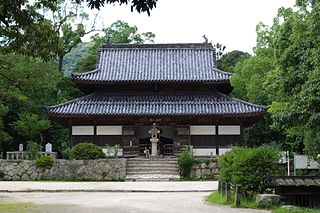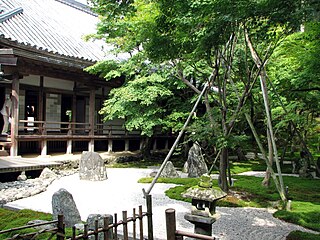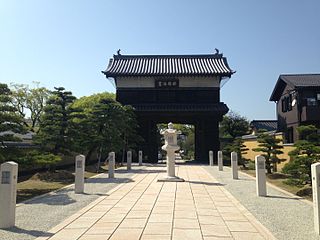 W
WBairin-ji (梅林寺) is a Rinzai temple in Kurume, Fukuoka Prefecture, Japan. Its honorary sangō prefix is Kōnanzan (江南山). It is known as a representative training dojo temple of the Myōshin-ji school in Kyushu which faces the clear stream of the Chikugo River.
 W
WFukugon-ji (福厳寺) is an Ōbaku Zen temple in Yanagawa, Fukuoka, Japan. Its honorary sangō prefix is Baigakuzan (梅岳山).
 W
WFukuju-ji (福聚寺) is an Ōbaku Zen temple in Kokurakita-ku, Kitakyūshū, Fukuoka, Japan. Its honorary sangō prefix is Kōjuzan (広寿山). Fukuju-ji is one of two bodaiji (菩提寺), or funeral temples, dedicated to Ogasawara Tadazane, the first daimyō of Kokura Domain.
 W
WJōten-ji (承天寺) is a Rinzai temple in Hakata, Fukuoka, Japan. Its honorary sangō prefix is Banshōsan (萬松山). It was founded by Enni-Ben'en with support from Xie Guo Ming, a Chinese merchant, and construction was completed in 1242.
 W
WKaidan-in (戒壇院) is a Rinzai temple in Dazaifu, Fukuoka Prefecture, Japan. It was founded by Ganjin in 761.
 W
WKanzeon-ji (観世音寺) is a seventh-century Buddhist temple in Dazaifu, Fukuoka, Fukuoka Prefecture, Japan. It was once the most important temple in Kyushu. Its bell, one of the oldest in the country, has been designated a National Treasure, and in 1996 the Ministry of the Environment designated its sound as one of the 100 Soundscapes of Japan. Many statues of the Heian period are Important Cultural Properties.
 W
WKiyomizu-dera (清水寺) is a Tendai temple in Miyama, Fukuoka, Japan. Its honorary sangō prefix is Motoyoshizan (本吉山).
 W
WKōmyōzen-ji (光明禅寺) is a Zen temple in Dazaifu, Fukuoka Prefecture, Japan. It was founded by Tetsugyū Enshin of the Tōfuku-ji Rinzai school in 1273. Kōmyōzen-ji is celebrated for its karesansui garden, the only example in Kyushu.
 W
WKōshū-ji (興宗寺), also pronounced as Kōsō-ji, is a Sōtō Zen Buddhist temple in Minami-ku, Fukuoka, Japan. The temple stands under the cavern of Takamiya where the old tombs existed.
 W
WNyōirin-ji (如意輪寺) is a Shingon temple in Ogōri, Fukuoka Prefecture, Japan. The temple, which is famed for its frog things, is commonly referred to as Kaeru-dera (カエル寺), meaning "frog temple", while the formal name is Seieizan Nyōirin-ji (清影山如意輪寺).
 W
WSennyo-ji (千如寺) is a Shingon temple in Itoshima, Fukuoka Prefecture, Japan. Its honorary sangō prefix is Sennyo-ji Daihiō-in (千如寺大悲王院). It is also referred to as Raizan Kannon (雷山観音).
 W
WShōfuku-ji (聖福寺) is a Rinzai temple in Hakata, Fukuoka, Japan. Its honorary sangō prefix is Ankokuzan (安国山). It was founded by Eisai with support from Minamoto no Yoritomo, and construction was completed in 1195, making it the oldest Zen temple in Japan.
 W
WShōkaku-ji (正覚寺) is a Rinzai temple in Jōnan-ku, Fukuoka, Japan. Its honorary sangō prefix is Higashiaburayama (東油山). It is also referred to as Aburayama Kannon (油山観音).
 W
WSōfuku-ji (崇福寺) is a Rinzai temple in Hakata-ku, Fukuoka, Japan. Its honorary sangō prefix is Yokodakezan (横岳山). The temple was founded by the monk Tan'e (湛慧) in Dazaifu in 1240, but was moved to its present location in 1600 after it became the Kuroda family temple.
 W
WTōchō-ji (東長寺) is a Shingon temple in Hakata, Fukuoka, Japan. Its honorary sangō prefix is Nangakuzan (南岳山). It was founded by Kūkai in 806, making it the oldest Shingon temple in Kyushu.